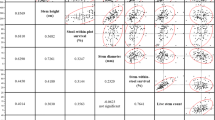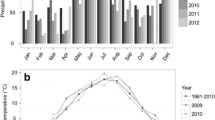Abstract
The objectives of this study were to estimate biomass production in commercially grown short rotation coppice willow in Denmark and to investigate effects of site and management factors on willow yield. Biomass production assessed by non-destructive sampling on 296 plots from 25 plantations was analyzed using a mixed model approach. Average production in the stands varied between 2.4 and 15.1 odt ha−1 year−1, and average second rotation growth (8.2 odt ha−1 year−1) was significantly higher than first rotation growth (6.5 odt ha−1 year−1). Annual production was significantly correlated with clone, soil texture, soil drainage, fertilization, weeds, rotation number, and shoot age. Further, interactions between clone and soil drainage as well as between clone and soil texture were significant, indicating the importance of a site-specific choice of clones.







Similar content being viewed by others
References
European Commission. Directive (2009) 2009/28/EC of the European parliament and of the Council of the 23 April 2009 on the promotion of the use of energy from renewable sources. European Commission, Brussels
Ericsson K, Nilsson LJ (2006) Assessment of the potential biomass supply in Europe using a resource-focused approach. Biomass Bioenergy 30(1):1–15
Slade R, Saunders R, Gross R, Bauen A (2011) Energy from biomass: the size of the global resource. Imperial College Centre for Energy Policy and Technology and UK Energy Research Centre, London
European Environment Agency (2006) How much bioenergy can Europe produce without harming the environment? EEA Report No 7/2006, Copenhagen
Mola-Yudego B (2011) Trends and productivity improvements from commercial willow plantations in Sweden during the period 1986–2000. Biomass Bioenergy 35(1):446–453
Venendaal R, Jorgensen U, Foster CA (1997) European energy crops: a synthesis. Biomass Bioenergy 13(3):147–185
Karp A, Hanley SJ, Trybush SO, Macalpine W, Pei M, Shield I (2011) Genetic improvement of willow for bioenergy and biofuels. J Integr Plant Biol 53(2):151–165
Larsson S (2001) Commercial varieties from the Swedish willow breeding programme. Aspe Appl Biol 65 (Biomass and Energy Crops II) 193
Larsson S (1998) Genetic improvement of willow for short-rotation coppice. Biomass Bioenergy 15(1):23–26
Lindegaard K, Parfitt RI, Donaldson G, Hunter T, Dawson WM, Forbes EGA, et al. (2001) Comparative trials of elite Swedish and UK biomass willow varieties. Aspe Appl Biol 65 (Biomass and Energy Crops II)
Bullard MJ, Mustill SJ, McMillan SD, Nixon PMI, Carver P, Britt CP (2002) Yield improvements through modification of planting density and harvest frequency in short rotation coppice Salix spp.—1. Yield response in two morphologically diverse varieties. Biomass Bioenergy 22(1):15–25
Stolarski M, Szczukowski S, Tworkowski J, Klasa A (2008) Productivity of seven clones of willow coppice in annual and quadrennial cutting cycles. Biomass Bioenergy 32(12):1227–1234
Willebrand E, Ledin S, Verwijst T (1993) Willow coppice systems in short-rotation forestry—effects of plant spacing, rotation length and clonal composition on biomass production. Biomass Bioenergy 4(5):323–331
Bergkvist P, Ledin S (1998) Stem biomass yields at different planting designs and spacings in willow coppice systems. Biomass Bioenergy 14(2):149–156
Wilkinson JM, Evans EJ, Bilsborrow PE, Wright C, Hewison WO, Pilbeam DJ (2007) Yield of willow cultivars at different planting densities in a commercial short rotation coppice in the north of England. Biomass Bioenergy 31(7):469–474
Sage RB (1999) Weed competition in willow coppice crops: the cause and extent of yield losses. Weed Res 39(5):399–411
Tahvanainen L, Rytkönen VM (1999) Biomass production of Salix viminalis in southern Finland and the effect of soil properties and climate conditions on its production and survival. Biomass Bioenergy 16(2):103–117
Adegbidi HG, Briggs RD, Volk TA, White EH, Abrahamson LP (2003) Effect of organic amendments and slow-release nitrogen fertilizer on willow biomass production and soil chemical characteristics. Biomass Bioenergy 25(4):389–398
Bonosi L, Ghelardini L, Weih M (2010) Growth responses of 15 Salix genotypes to temporary water stress are different from the responses to permanent water shortage. Trees-Struct Funct 24(5):843–854
Alriksson B (1997) Influence of site factors on Salix growth with emphasis on nitrogen response under different soil conditions. Acta universitatis agriculturae Sueciae, Silvestria, 46
Hofmann-Schielle C, Jug A, Makeschin F, Rehfuess KE (1999) Short-rotation plantations of balsam poplars, aspen and willows on former arable land in the Federal Republic of Germany. I. Site-growth relationships. For Ecol Manag 121(1–2):41–55
Labrecque M, Teodorescu TI (2003) High biomass yield achieved by Salix clones in SRIC following two 3-year coppice rotations on abandoned farmland in southern Quebec, Canada. Biomass Bioenergy 25(2):135–146
Lindroth A, Bath A (1999) Assessment of regional willow coppice yield in Sweden on basis of water availability. For Ecol Manag 121(1–2):57–65
Adegbidi HG, Volk TA, White EH, Abrahamson LP, Briggs RD, Bickelhaupt DH (2001) Biomass and nutrient removal by willow clones in experimental bioenergy plantations in New York State. Biomass Bioenergy 20(6):399–411
Alriksson B, Ledin S, Seeger P (1997) Effect of nitrogen fertilization on growth in a Salix viminalis stand using a response surface experimental design. Scand J For Res 12(4):321–327
Aronsson P, Rosenqvist H (2011) Gödslingsrekommendationer för Salix 2011 (In Swedish). SLU, Institut för Växtproduktionsekologi, Rapport 23 marts 2011
Cavanagh A, Gasser MO, Labrecque M (2011) Pig slurry as fertilizer on willow plantation. Biomass Bioenergy 35(10):4165–4173
Quaye AK, Volk TA, Hafner S, Leopold DJ, Schirmer C (2011) Impacts of paper sludge and manure on soil and biomass production of willow. Biomass Bioenergy 35(7):2796–2806
Aylott MJ, Casella E, Tubby I, Street NR, Smith P, Taylor G (2008) Yield and spatial supply of bioenergy poplar and willow short-rotation coppice in the UK. New Phytol 178(2):358–370
Karp A, Shield I (2008) Bioenergy from plants and the sustainable yield challenge. New Phytol 179(1):15–32
Mola-Yudego B, Aronsson P (2008) Yield models for commercial willow biomass plantations in Sweden. Biomass Bioenergy 32(9):829–837
Morsing M, Nielsen KH (1995) Tørstofproduktion i danske pilekulturer 1989-(In Danish). Forskningscentret for Skov & Landskab, Skovbrugsserien 1995;13
Sundberg PS, Callesen I, Greve MH, Raulund-Rasmussen K (1999) Danske jordbundsprofiler (In Danish). Danmarks Jordbrugs Forskning, Foulum
Danish Meteorological Institute (2011) Klimanormaler for Danmark (In Danish). http://www.dmi.dk/dmi/index/danmark/klimanormaler.htm. Accessed 7 July 2011
Nordh NE, Verwijst T (2004) Above-ground biomass assessments and first cutting cycle production in willow (Salix sp.) coppice—a comparison between destructive and non-destructive methods. Biomass Bioenergy 27(1):1–8
Sevel L, Nord-Larsen T, Raulund-Rasmussen K (2012) Biomass production of four willow clones grown as short rotation coppice on two soils in Denmark. Biomass Bioenergy 46:664–672
Telenius BF (1997) Implications of vertical distribution and within-stand variation in moisture content for biomass estimation of some willow and hybrid poplar clones. Scand J For Res 12(4):336–339
Sevel L, Nord-Larsen T, Ingerslev M, Jørgensen U, Raulund-Rasmussen K (2014) Fertilization of SRC willow, I: biomass production response. Bioenergy Res 7(1):319–328
Lantmännen Agroenergi (2011) Willow varieties 2010. Lantmännen Agroenergi, Huskvarna
Weih M, Nordh NE (2002) Characterising willows for biomass and phytoremediation: growth, nitrogen and water use of 14 willow clones under different irrigation and fertilisation regimes. Biomass Bioenergy 23(6):397–413
Lantmännen SW seed AB (2011) Willow varieties 2011. Lantmännen SW seed AB Onsjövägen 13, Svalöv
Macalpine WJ, Shield I, Karp A (2010) Seed to near market variety; the BEGIN willow breeding pipeline 2003–2010 and beyond. Bioten Conf Proceedings, Birmingham 21–23 September 2010
Labrecque M, Teodorescu TI (2001) Influence of plantation site and wastewater sludge fertilization on the performance and foliar nutrient status of two willow species grown under SRIC in southern Quebec (Canada). For Ecol Manag 150(3):223–239
Jackson MB, Attwood PA (1996) Roots ow willow (Salix viminalis L.) show marked tolerance to oxygen shortage in flooded soils and in solution culture. Plant Soil 187(1):37–45
Li S, Pezeshki SR, Shields FDS Jr (2006) Partial flooding enhances aeration in adventitious roots of black willow (Salix nigra) cuttings. J Plant Physiol 163(6):619–628
Danfors B, Ledin S, Rosenqvist H (1997) Energiskogsodling: Handledning för odlare (In Swedish). Jordbrukstekniska Institutet
Clay DV, Dixon FL (1997) Effect of ground-cover vegetation on the growth of poplar and willow short-rotation coppice. Asp Appl Biol Biomass Energ Crops 49:53–60
Labrecque M, Teodorescu TI, Babeux P, Cogliastro A, Daigle S (1994) Impact of herbaceous competition and drainage conditions on the early productivity of willows under short-rotation intensive culture. Can J For Res 24(3):493–501
Volk TA, Abrahamson LP, White EH, Robison DJ (2002) Alternative methods of site preparation for short-rotation willow and poplar biomass crops. Biomass power for rural development Final report prepared for the United States Department of Energy under cooperative agreement No DE-FC36-96GO10132
Dimitriou I, Eriksson J, Adler A, Aronsson P, Verwijst T (2006) Fate of heavy metals after application of sewage sludge and wood-ash mixtures to short-rotation willow coppice. Environ Pollut 142(1):160–169
Jug A, Hofmann-Schielle C, Makeschin F, Rehfuess KE (1999) Short-rotation plantations of balsam poplars, aspen and willows on former arable land in the Federal Republic of Germany. II. Nutritional status and bioelement export by harvested shoot axes. For Ecol Manag 121(1–2):67–83
Nordh NE (2005) Long term changes in stand structure and biomass production in short rotation willow coppice. Doctoral Thesis No 2005:120 Acta Univer Agri Sueciae Dep of Crop Prod Ecol, Uppsala
Volk TA, Abrahamson LP, Cameron KD, Castellano PJ, Corbin T, Fabio E, Johnson G, Kuzovkina-Eischen Y, Labrecque M, Miller R, Sidders D, Smart LB, Staver K, Stanosz GR, Rees K van (2011) Yields of willow biomass crops across a range of sites in North America. Asp Appl Biol (112):67–74
Kopp RF, Abrahamson LP, White EH, Burns KF, Nowak CA (1997) Cutting cycle and spacing effects on biomass production by a willow clone in New York. Biomass Bioenergy 12(5):313–319
Kopp RF, Abrahamson LP, White EH, Volk TA, Nowak CA, Fillhart RC (2001) Willow biomass production during ten successive annual harvests. Biomass Bioenergy 20(1):1–7
Stolarski MJ, Szczukowski S, Tworkowski J, Wroblewska H, Krzyzaniak M (2011) Short rotation willow coppice biomass as an industrial and energy feedstock. Ind Crop Prod 33(1):217–223
Willebrand E, Verwijst T (1993) Population-dynamics of willow coppice systems and their implications for management of short-rotation forests. For Chron 69(6):699–704
Dansk Landbrugsrådgivning (2011) Dyrkningsvejledning, Pil (In Danish). https://www.landbrugsinfo.dk/planteavl/afgroeder/energiafgroeder/pil-energiskov/sider/startside.aspx. Accessed 10 Jan 2011
Acknowledgments
This study was funded by HedeDanmark A/S, Dalgas Innovation, Department of Geosciences and Natural Resource Management University of Copenhagen, and the Danish Agency for Science Technology and Innovation. We greatly acknowledge the 14 farmers for the use of their SRC willow stands and providing us with the historic information. We thank Lise Bak for weighing shoots and for the determination of moisture content and senior scientists Morten Ingerslev and Uffe Jørgensen for the discussion of the experimental design and evaluation of the results.
Author information
Authors and Affiliations
Corresponding author
Rights and permissions
About this article
Cite this article
Nord-Larsen, T., Sevel, L. & Raulund-Rasmussen, K. Commercially Grown Short Rotation Coppice Willow in Denmark: Biomass Production and Factors Affecting Production. Bioenerg. Res. 8, 325–339 (2015). https://doi.org/10.1007/s12155-014-9517-6
Published:
Issue Date:
DOI: https://doi.org/10.1007/s12155-014-9517-6




